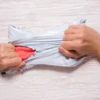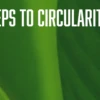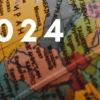¿Vende ropa, calzado o textiles en Francia? Aún está a tiempo de cumplir con las normativas y evitar multas costosas.
¿Cuáles son los requisitos de etiquetado Triman para la ropa en Francia?
Triman es un sistema de etiquetado obligatorio relacionado con el tratamiento al final de la vida útil de los productos de consumo y profesionales. En febrero de 2022, se amplió para incluir prendas de vestir, textiles y calzado. El etiquetado debe cumplir con los requisitos muy específicos establecidos por el Ministerio de Transición Ecológica francés, y el incumplimiento se castiga con una multa.
Si eres una marca de moda o estilo de vida que fabrica productos en Francia o los importa al país, es posible que ya hayas oído hablar de los requisitos de etiquetado Triman. Y si no es así, debes informarte y cumplir con la normativa, porque la fecha límite final para que todo tu stock cumpla con la normativa se acerca rápidamente.Para muchas marcas es fundamental comprender y adaptarse a todas las complejidades de los requisitos de etiquetado Triman para prendas de vestir, textiles y calzado. Y aunque requieren cambios en sus operaciones, hay muchas formas de adelantarse a la curva de cumplimiento y evitar multas costosas. Pero, ¿de qué se trata realmente?
Introducción al sistema de etiquetado Triman en Francia
Triman es un marco de etiquetado para productos de consumo y profesionales en Francia. Se relaciona con el tratamiento al final de la vida útil de estos productos y se enmarca en la ley francesa Anti-residuos para una economía circular, también conocida como AGEC.
Los nuevos requisitos de etiquetado entraron en vigor a principios de 2022 y cubren una amplia variedad de prendas de vestir, textiles para el hogar y calzado. Los requisitos son válidos para todos los artículos fabricados o importados en Francia y cubren todo tipo de plataformas de venta. Esto incluye el comercio electrónico, las tiendas de fábrica, los vendedores autónomos y los mercados de segunda mano.
Según la ley AGEC, se le considera productor (o "comercializador") si fabrica, importa, ensambla o "introduce en el mercado nacional" de otro modo productos de las categorías de prendas de vestir, ropa de hogar y calzado. Si usted es uno de los siguientes tipos de partes, está sujeto a esta legislación:
- Un fabricante o un mandante que venda en Francia artículos (fabricados en Francia o en el extranjero) con su marca
- Un importador (mayorista o minorista) de marcas nacionales o internacionales
- Un distribuidor de su propia marca o de productos importados directamente (minorista multimarca)
Por lo tanto, incluso si usted es una marca de moda holandesa que importa ropa a Francia, la ley francesa le exige que cumpla con las normas de etiquetado Triman si también vende la ropa. La responsabilidad final siempre recae en la parte que entrega los productos al mercado (conocido como "metteur en marché").
Por ejemplo, un mayorista que opera en Francia y que importa ropa sin etiqueta al país sería responsable de agregar la etiqueta Triman correcta antes de vender estos productos. Este es el caso para todas las demás categorías de productos aplicables.Para los importadores: los funcionarios de aduanas no verificarán la presencia de una etiqueta Triman en la ropa, el calzado o los textiles importados. Los controles serán realizados por organizaciones gubernamentales como la Direction départementale de la protection des populations (DDPP) y la Direction générale de la concurrence, de la consommation et de la répression des frauds (DGCCRF).

¿Quiere saber más sobre la circularidad y cómo podría beneficiarle? Descargue nuestro informe aquí: Leading Circular 2023
¿Qué son las Organizaciones de Responsabilidad del Productor?
Antes de poder empezar a operar como vendedor de ropa, calzado o textiles para el hogar en el mercado francés, deberá registrarse en una organización de responsabilidad del productor (ORP). Estas organizaciones acompañan la transición circular para varias categorías de productos. Actualmente, la única ORP para ropa, calzado y textiles es ReFashion.
Como marca de moda o estilo de vida en Francia, debe pagar contribuciones ecológicas a ReFashion para cumplir con la legislación francesa de responsabilidad extendida del productor (REP). Su empresa paga por cada prenda que pone en el mercado, lo que en la práctica subsidia su reutilización o reciclaje. Esto está diseñado para reducir la cantidad de ropa que se envía a los vertederos.Una vez que su empresa se haya registrado en la ORP, puede solicitar registrarse en ADEME (la Agencia Francesa para la Transición Ecológica) para recibir un número de identificación único ("Identifiant Unique", o UIN). Este es un requisito legal para cualquier persona u organización que venda ropa, calzado o textiles en Francia.
Nota: casi todas las marcas deben registrarse en dos PRO: una para cubrir sus productos de ropa y otra para el embalaje en el que se entregan. Si tiene una operación de comercio electrónico, es recomendable consultar con su proveedor de logística si también necesita registrarse en una PRO para el embalaje en el que se entregan sus productos. Es posible que su proveedor ya esté registrado en la PRO correspondiente para su embalaje.
¿Cuándo se exigirá a una marca cumplir con la normativa de etiquetado Triman para prendas de vestir?
En teoría, la normativa Triman entró en vigor el 1 de febrero de 2023. Todos los productos creados en Francia o importados en Francia después de esta fecha deben llevar adherida una etiqueta Triman + info-tri. Sin embargo, las marcas han concedido un plazo de gracia de seis meses. Esto significa que toda prenda creada o importada antes del 1 de febrero de 2023 podrá venderse sin etiqueta Triman hasta el 1 de agosto de 2023.
A partir del 1 de agosto de 2023, todos los productos textiles y de calzado comercializados en el mercado francés (y creados en Francia para la exportación) deberán llevar la etiqueta correcta. Cualquier producto vendido sin la etiqueta Triman adecuada se sancionará con una multa por infracción de 3.000 EUR para las personas físicas y de 15.000 EUR para las personas jurídicas (es decir, empresas). ¡No te dejes engañar!
¿Qué productos de ropa deben llevar la etiqueta Triman en Francia?
Los requisitos de etiquetado Triman cubren una amplia variedad de prendas de vestir, productos textiles y calzado. La siguiente tabla describe los tipos de productos que están incluidos en los requisitos y cuáles están exentos. Sin embargo, debe tenerse en cuenta que muchos artículos "exentos" están cubiertos por un flujo EPR separado, lo que significa que también deben etiquetarse.
| Categoría de producto | Incluido | Exento |
| Ropa | La mayoría de las prendas de vestir, incluidos calcetines, ropa interior, pantalones, bufandas, camisetas, chalecos y abrigos. | Artículos de cuero, artículos de piel natural y artículos de vestuario puramente decorativos como alas de hadas o máscaras (tenga en cuenta que hay un flujo EPR separado para juguetes y juegos). |
| Calzado | La mayoría de los zapatos, incluidas sandalias, pantuflas, zapatos náuticos, zapatos de bebé y zapatillas deportivas. | Calzado de protección (compatible con la norma ISO 20345) y calzado deportivo especializado, incluidas botas de esquí, zapatillas de ciclismo y patines de hielo (estos artículos se incluyen en la sección EPR de Deporte y Ocio). |
| Textiles para el hogar | La mayoría de los textiles para el hogar, incluida la ropa de cama, manteles, toallas de baño y batas. | Alfombras, cojines, cabeceros, hules, persianas venecianas, revestimientos para muebles y separadores de ambientes (estos artículos están cubiertos por la corriente EPR de Muebles). |
Nota: los accesorios como los paraguas no están incluidos actualmente en las normas de etiquetado Triman. Hay disponible para descargar una gama completa de prendas de vestir cubiertas por las normas de etiquetado Triman aquí.
¿Cómo es la etiqueta Triman para la ropa?
El diseño exacto del logotipo de Triman y la información de clasificación que lo acompaña han sido aprobados por el Ministerio de Transición Ecológica de Francia. Es importante respetar las directrices de diseño y las dimensiones exactas de todos los elementos de la etiqueta. El logotipo de Triman y los pictogramas de información de clasificación están disponibles para su descarga sin licencia para los miembros de ReFashion.
Tenga en cuenta que el uso de los recursos gráficos de Triman solo es gratuito para las empresas y personas registradas en el organismo de responsabilidad del productor correspondiente al flujo EPR en cuestión (ReFashion para ropa, calzado y textiles, Citéo para embalajes y papel y Ecomaison, anteriormente Eco-mobilier, para muebles). Descubra las pautas de ReFashion.
¿Qué debe incluir la etiqueta Triman de la ropa?
La etiqueta Triman debe estar formada siempre (salvo en casos excepcionales) por dos elementos principales: la pequeñafigura humana con cuatro flechas (el logotipo de Triman) y la información de clasificación (el «info-tri»). A continuación se muestran varios ejemplos de cómo puede aparecer la etiqueta Triman completa (logotipo + info-tri) en el producto y su embalaje.

¿Qué tamaño deben tener las etiquetas Triman para ropa, calzado y telas?

Cada etiqueta debe contener el logotipo de Triman, las iniciales «FR», los símbolos de información de clasificación y la dirección URL. La etiqueta debe medir un mínimo de 2,7 cm de ancho para la versión horizontal o 2,7 cm de alto para la versión vertical. La altura mínima (para la versión horizontal) es de 1 cm o 0,6 cm en caso de dificultades técnicas.
Atención: las proporciones de los elementos gráficos deben respetarse siempre y no es posible separar los elementos de la etiqueta; esta debe aparecer siempre como una unidad. La pequeña figura humana con las flechas no constituye una etiqueta Triman.
¿Cómo debe fijarse la etiqueta Triman en la ropa y el calzado?
La etiqueta Triman se puede coser directamente sobre los productos, como las etiquetas de instrucciones de cuidado. Otra posibilidad es imprimirla o estamparla directamente sobre el producto o su embalaje. Si no resulta práctico colocar o imprimir una etiqueta directamente, se recomienda imprimir la etiqueta Triman sobre elementos adheridos, como etiquetas colgantes. Otra posibilidad es imprimir la etiqueta Triman sobre cualquier documentación adjunta, como un folleto de instrucciones de uso. También es posible utilizar una pegatina Triman, por ejemplo, en el caso de los zapatos.
Nota 1: si utiliza la opción de etiqueta colgante o folleto, debe imprimir dos logotipos Triman en la etiqueta/folleto: uno para cubrir la prenda de vestir/calzado/textil y otro para cubrir la etiqueta de cartón/folleto de papel. Esto se debe a que la etiqueta/folleto pasará a formar parte de un flujo de residuos gestionado por Citéo (papel y embalaje), mientras que la ropa quedará cubierta por ReFashion.
Nota 2: si un producto (por ejemplo, un set de regalo) contiene distintas categorías de productos, es necesario que las etiquetas Triman independientes estén visibles en los productos individuales o en el embalaje. Esto es para cubrir los requisitos de eliminación de cada categoría de producto por separado (por ejemplo, ropa y artículos para el hogar).
¿Qué variaciones del etiquetado Triman para prendas de vestir son aceptables?
No se permite modificar las especificaciones de diseño aprobadas. Sin embargo, existen suficientes opciones de etiquetado dentro de los diseños aprobados para reflejar una amplia gama de situaciones posibles. Por ejemplo, existen varias opciones diferentes para ordenar los íconos de información (‘info-tri’), lo que le permite personalizar la etiqueta según las especificaciones de su producto.
Nota: si su marca vende zapatos, ropa y textiles para el hogar, es aceptable agregar la opción ‘camiseta, toalla doblada y zapato’ a todos sus productos, sin importar cuáles sean:También es posible indicar que su empresa opera un servicio de recolección en tienda para ropa usada agregando el ícono de ‘recolección en tienda’, como se muestra a continuación:
¿Cuáles son los requisitos de etiquetado adicionales para Triman?
La mayoría de las prendas de vestir, calzado y artículos textiles para el hogar se entregan en envases que deben llevar su propia etiqueta Triman, distinta de la etiqueta que hace referencia a la propia prenda. Tomemos como ejemplo un par de zapatos en una caja de cartón. Los zapatos deben llevar impresa o pegada la siguiente etiqueta, ya sea cosida o mediante una pegatina:
Por otra parte, la propia caja de cartón debe llevar una etiqueta Triman de Citéo, la organización de responsabilidad del productor que supervisa la gestión de los residuos de envases.Las dos etiquetas Triman diferentes, una de ReFashion y otra de Citéo, no se pueden combinar en una sola etiqueta, ya que se refieren a diferentes flujos de REP.
¿Existen ecepciones a los requisitos de etiquetado Triman para la ropa?
Si la superficie de un producto no admite una etiqueta Triman, se puede utilizar una etiqueta Triman (semi)digital. Si la superficie más grande del producto mide menos de 10 cm2 y no se incluye documentación de respaldo, la etiqueta Triman en su totalidad puede estar disponible en línea. Para facilitar el acceso, se recomienda un código QR o similar.
Si la superficie más grande del producto mide entre 10 cm2 y 20 cm2 y no se incluye documentación de respaldo, el logotipo Triman (la figura humana con las cuatro flechas) debe colocarse en el producto, pero la etiqueta completa (el logotipo Triman + la información de clasificación) debe estar disponible en línea, accesible, por ejemplo, a través de un código QR.
¿Qué pasa si no logro vender todo el stock no conforme antes del 1 de agosto de 2023?
Todo stock presente en el mercado francés que no lleve el logotipo Triman se considerará una infracción de la legislación francesa. Las marcas que no hayan conseguido vender todo el stock no etiquetado o colocar etiquetas en el stock existente antes de la fecha límite del 1 de agosto de 2023 podrán colocar las etiquetas correctas directamente en los productos en forma de pegatinas.
¿Cómo puede Bleckmann ayudarle a lograr la conformidad con Triman para la ropa?
Ahora que ha pasado la fecha límite para el cumplimiento de Triman, es comprensible que le preocupe cómo su marca se las arreglará con las regulaciones actualizadas. A muchos les preocupará el costo y la complejidad logística de volver a etiquetar todo su stock existente y monitorear el cumplimiento en toda su cadena de suministro.
Entonces, ¿por qué no se pone en contacto con un equipo de Bleckmann hoy mismo y descubre cómo podemos ayudarlo a lograr el cumplimiento con una interrupción mínima de sus operaciones comerciales?














